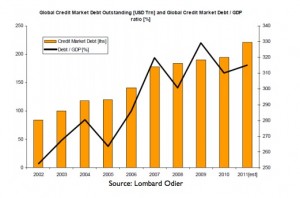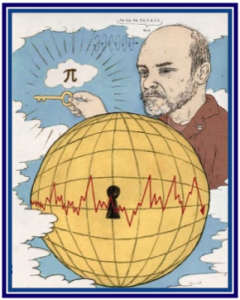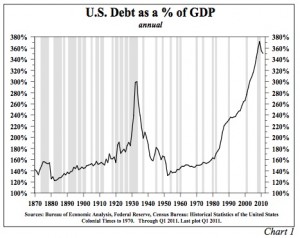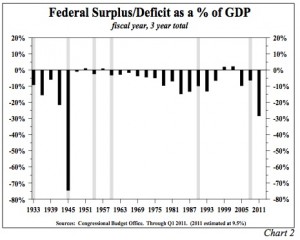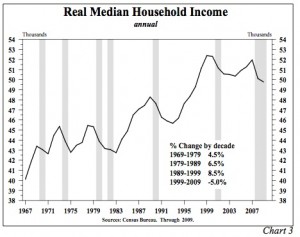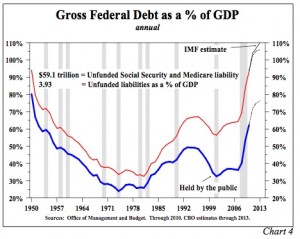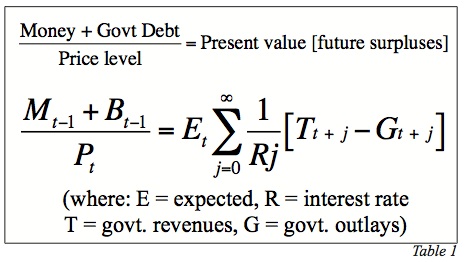At the invitation of the New York Federal Reserve Bank, I spoke and had lunch in the bank’s Liberty Room. Below are my prepared remarks.
Thank you very much for inviting me to speak here at the New York Federal Reserve Bank.
Intellectual discourse is, of course, extraordinarily valuable in reaching truth. In this sense, I welcome the opportunity to discuss my views on the economy and monetary policy and how they may differ with those of you here at the Fed.
That said, I suspect my views are so different from those of you here today that my comments will be a complete failure in convincing you to do what I believe should be done, which is to close down the entire Federal Reserve System
My views, I suspect, differ from beginning to end. From the proper methodology to be used in the science of economics, to the manner in which the macro-economy functions, to the role of the Federal Reserve, and to the accomplishments of the Federal Reserve, I stand here confused as to how you see the world so differently than I do.
I simply do not understand most of the thinking that goes on here at the Fed and I do not understand how this thinking can go on when in my view it smacks up against reality.
Please allow me to begin with methodology, I hold the view developed by such great economic thinkers as Ludwig von Mises, Friedrich Hayek and Murray Rothbard that there are no constants in the science of economics similar to those in the physical sciences.
In the science of physics, we know that ice freezes at 32 degrees. We can predict with immense accuracy exactly how far a rocket ship will travel filled with 500 gallons of fuel. There is preciseness because there are constants, which do not change and upon which equations can be constructed..
There are no such constants in the field of economics since the science of economics deals with human action, which can change at any time. If potato prices remain the same for 10 weeks, it does not mean they will be the same the following day. I defy anyone in this room to provide me with a constant in the field of economics that has the same unchanging constancy that exists in the fields of physics or chemistry.
And yet, in paper after paper here at the Federal Reserve, I see equations built as though constants do exist. It is as if one were to assume a constant relationship existed between interest rates here and in Russia and throughout the world, and create equations based on this belief and then attempt to trade based on these equations. That was tried and the result was the blow up of the fund Long Term Capital Management, a blow up that resulted in high level meetings in this very building.
It is as if traders assumed a given default rate was constant for subprime mortgage paper and traded on that belief. Only to see it blow up in their faces, as it did, again, with intense meetings being held in this very building.
Yet, the equations, assuming constants, continue to be published in papers throughout the Fed system. I scratch my head.
I also find curious the general belief in the Keynesian model of the economy that somehow results in the belief that demand drives the economy, rather than production. I look out at the world and see iPhones, iPads, microwave ovens, flat screen televisions, which suggest to me that it is production that boosts an economy. Without production of these things and millions of other items, where would we be? Yet, the Keynesians in this room will reply, “But you need demand to buy these products.” And I will reply, “Do you not believe in supply and demand? Do you not believe that products once made will adjust to a market clearing price?”
Further , I will argue that the price of the factors of production will adjust to prices at the consumer level and that thus the markets at all levels will clear. Again do you believe in supply and demand or not?
I scratch my head that somehow most of you on some academic level believe in the theory of supply and demand and how market setting prices result, but yet you deny them in your macro thinking about the economy.
You will argue with me that prices are sticky on the downside, especially labor prices and therefore that you must pump money to get the economy going. And, I will look on in amazement as your fellow Keynesian brethren in the government create an environment of sticky non-downward bending wages.
The economist Robert Murphy reports that President Herbert Hoover continually pressured businessmen to not lower wages.[1]
He quoted Hoover in a speech delivered to a group of businessmen:
In this country there has been a concerted and determined effort on the part of government and business… to prevent any reduction in wages.
He then reports that FDR actually outdid Hoover by seeking to “raise wages rates rather than merely put a floor under them.”
I ask you, with presidents actively conducting policies that attempt to defy supply and demand and prop up wages, are you really surprised that wages were sticky downward during the Great Depression?
In present day America, the government focus has changed a bit. In the new focus, the government attempts much more to prop up the unemployed by extended payments for not working. Is it really a surprise that unemployment is so high when you pay people not to work.? The 2010 Nobel Prize was awarded to economists for their studies which showed that, and I quote from the Noble press release announcing the award:
One conclusion is that more generous unemployment benefits give rise to higher unemployment and longer search times.[2]
Don’t you think it would make more sense to stop these policies which are a direct factor in causing unemployment, than to add to the mess and devalue the currency by printing more money?
I scratch my head that somehow your conclusions about unemployment are so different than mine and that you call for the printing of money to boost “demand”. A call, I add, that since the founding of the Federal Reserve has resulted in an increase of the money supply by 12,230%.
I also must scratch my head at the view that the Federal Reserve should maintain a stable price level. What is wrong with having falling prices across the economy, like we now have in the computer sector, the flat screen television sector and the cell phone sector? Why, I ask, do you want stable prices? And, oh by the way, how’s that stable price thing going for you here at the Fed?
Since the start of the Fed, prices have increased at the consumer level by 2,241% [3]. that’s not me misspeaking, I will repeat, since the start of the Fed, prices have increased at the consumer level by 2,241%.
So you then might tell me that stable prices are only a secondary goal of the Federal Reserve and that your real goal is to prevent serious declines in the economy but, since the start of the Fed, there have been 18 recessions including the Great Depression and the most recent Great Recession. These downturns have resulted in stock market crashes, tens of millions of unemployed and untold business bankruptcies.
I scratch my head and wonder how you think the Fed is any type of success when all this has occurred.
I am especially confused, since Austrian business cycle theory (ABCT), developed by Mises, Hayek and Rothbard, has warned about all these things. According to ABCT, it is central bank money printing that causes the business cycle and, again you here at the Fed have certainly done that by increasing the money supply. Can you imagine the distortions in the economy caused by the Fed by this massive money printing?
According to ABCT, if you print money those sectors where the money goes will boom, stop printing and those sectors will crash. Fed printing tends to find its way to Wall Street and other capital goods sectors first, thus it is no surprise to Austrian school economists that the crashes are most dramatic in these sectors, such as the stock market and real estate sectors. The economist Murray Rothbard in his book America’s Great Depression [4] went into painstaking detail outlining how the changes in money supply growth resulted in the Great Depression.
On a more personal level, as the recent crisis was developing here, I warned throughout the summer of 2008 of the impending crisis. On July 11, 2008 at EconomicPolicyJournal.com, I wrote[5]:
SUPER ALERT: Dramatic Slowdown In Money Supply Growth
After growing at near double digit rates for months, money growth has slowed dramatically. Annualized money growth over the last 3 months is only 5.2%. Over the last two months, there has been zero growth in the M2NSA money measure.
This is something that must be watched carefully. If such a dramatic slowdown continues, a severe recession is inevitable.
We have never seen such a dramatic change in money supply growth from a double digit climb to 5% growth. Does Bernanke have any clue as to what the hell he is doing?
On July 20, 2008, I wrote [6]:
I have previously noted that over the last two months money supply has been collapsing. M2NSA has gone from double digit growth to nearly zero growth .
A review of the credit situation appears worse. According to recent Fed data, for the 13 weeks ended June 25, bank credit (securities and loans) contracted at an annual rate of 7.9%.
There has been a minor blip up since June 25 in both credit growth and M2NSA, but the growth rates remain extremely slow.
If a dramatic turnaround in these numbers doesn’t happen within the next few weeks, we are going to have to warn of a possible Great Depression style downturn.
Yet, just weeks before these warnings from me, Chairman Bernanke, while the money supply growth was crashing, had a decidedly much more optimistic outlook, In a speech on June 9, 2008, At the Federal Reserve Bank of Boston’s 53rd Annual Economic Conference [7], he said:
I would like to provide a brief update on the outlook for the economy and policy, beginning with the prospects for growth. Despite the unwelcome rise in the unemployment rate that was reported last week, the recent incoming data, taken as a whole, have affected the outlook for economic activity and employment only modestly. Indeed, although activity during the current quarter is likely to be weak, the risk that the economy has entered a substantial downturn appears to have diminished over the past month or so. Over the remainder of 2008, the effects of monetary and fiscal stimulus, a gradual ebbing of the drag from residential construction, further progress in the repair of financial and credit markets, and still-solid demand from abroad should provide some offset to the headwinds that still face the economy.
I believe the Great Recession that followed is still fresh enough in our minds so it is not necessary to recount in detail as to whose forecast, mine or the chairman’s, was more accurate.
I am also confused by many other policy making steps here at the Federal Reserve. There have been more changes in monetary policy direction during the Bernanke era then at any other time in the modern era of the Fed. Not under Arthur Burns, not under G. William Miller, not under Paul Volcker, not under Alan Greenspan have there been so many dramatically shifting Fed monetary policy moves. Under Chairman Bernanke there have been significant changes in direction of the money supply growth FIVE different times. Thus, for me, I am not at all surprised at the current stop and go economy. The current erratic monetary policy makes it exceedingly difficult for businessmen to make any long term plans. Indeed, in my own Daily Alert on the economy [8] I find it extremely difficult to give long term advice, when in short periods I have seen three month annualized M2 money growth go from near 20% to near zero, and then in another period see it go from 25% to 6% . [9]
I am also confused by many of the monetary programs instituted by Chairman Bernanke. For example, Operation Twist.
This is not the first time an Operation Twist was tried. an Operation Twist was tried in 1961, at the start of the Kennedy Administration [10] A paper [11] was written by three Federal Reserve economists in 2004 that, in part, examined the 1960’s Operation Twist
Their conclusion (My bold):
A second well-known historical episode involving the attempted manipulation of the term structure was so-called Operation Twist. Launched in early 1961 by the incoming Kennedy Administration, Operation Twist was intended to raise short-term rates (thereby promoting capital inflows and supporting the dollar) while lowering, or at least not raising, long-term rates. (Modigliani and Sutch 1966)…. The two main actions of Operation Twist were the use of Federal Reserve open market operations and Treasury debt management operations..Operation Twist is widely viewed today as having been a failure, largely due to classic work by Modigliani and Sutch….
However, Modigliani and Sutch also noted that Operation Twist was a relatively small operation, and, indeed, that over a slightly longer period the maturity of outstanding government debt rose significantly, rather than falling…Thus, Operation Twist does not seem to provide strong evidence in either direction as to the possible effects of changes in the composition of the central bank’s balance sheet….
We believe that our findings go some way to refuting the strong hypothesis that nonstandard policy actions, including quantitative easing and targeted asset purchases, cannot be successful in a modern industrial economy. However, the effects of such policies remain quantitatively quite uncertain.
One of the authors of this 2004 paper was Federal Reserve Chairman Bernanke. Thus, I have to ask, what the hell is Chairman Bernanke doing implementing such a program, since it is his paper that states it was a failure according to Modigliani, and his paper implies that a larger test would be required to determine true performance.
I ask, is the Chairman using the United States economy as a lab with Americans as the lab rats to test his intellectual curiosity about such things as Operation Twist?
Further, I am very confused by the response of Chairman Bernanke to questioning by Congressman Ron Paul. To a seemingly near off the cuff question by Congressman Paul on Federal Reserve money provided to the Watergate burglars, Chairman Bernanke contacted the Inspector General’s Office of the Federal Reserve and requested an investigation [12]. Yet, the congressman has regularly asked about the gold certificates held by the Federal Reserve [13] and whether the gold at Fort Knox backing up the certificates will be audited. Yet there have been no requests by the Chairman to the Treasury for an audit of the gold.This I find very odd. The Chairman calls for a major investigation of what can only be an historical point of interest but fails to seek out any confirmation on a point that would be of vital interest to many present day Americans.
In this very building, deep in the underground vaults, sits billions of dollars of gold, held by the Federal Reserve for foreign governments. The Federal Reserve gives regular tours of these vaults, even to school children. [14] Yet, America’s gold is off limits to seemingly everyone and has never been properly audited. Doesn’t that seem odd to you? If nothing else, does anyone at the Fed know the quality and fineness of the gold at Fort Knox?
In conclusion, it is my belief that from start to finish the Fed is a failure. I believe faulty methodology is used, I believe that the justification for the Fed, to bring price and economic stability, has never been a success. I repeat, prices since the start of the Fed have climbed by 2,241% and there have been over the same period 18 recessions. No one seems to care at the Fed about the gold supposedly backing up the gold certificates on the Fed balance sheet. The emperor has no clothes. Austrian Business cycle theorists are regularly ignored by the Fed, yet they have the best records with regard to spotting overall downturns, and further they specifically recognized the developing housing bubble. Let it not be forgotten that in 2004, two economists here at the New York Fed wrote a paper [15] denying there was a housing bubble. I responded to the paper [16] and wrote:
The faulty analysis by [these] Federal Reserve economists… may go down in financial history as the greatest forecasting error since Irving Fisher declared in 1929, just prior to the stock market crash, that stocks prices looked to be at a permanently high plateau.
Data released just yesterday, now show housing prices have crashed to 2002 levels. [17]
I will now give you more warnings about the economy.
The noose is tightening on your organization, vast amounts of money printing are now required to keep your manipulated economy afloat. It will ultimately result in huge price inflation, or, if you stop printing, another massive economic crash will occur. There is no other way out.
Again, thank you for inviting me. You have prepared food, so I will not be rude, I will stay and eat.
Let’s have one good meal here. Let’s make it a feast. Then I ask you, I plead with you, I beg you all, walk out of here with me, never to come back. It’s the moral and ethical thing to do. Nothing good goes on in this place. Let’s lock the doors and leave the building to the spiders, moths and four-legged rats.
